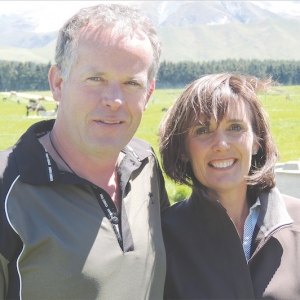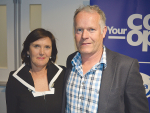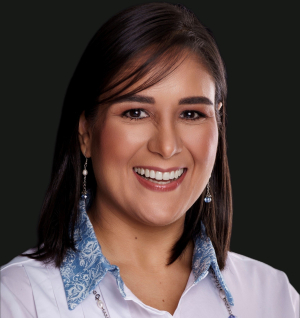Low input systems are highly profitable and more resilient in the see-saw world of modern dairy markets, say the runners-up of the 2014 Dairy Business of the Year.
Kieran and Leonie Guiney run four dairy farms and 2800 cows near Fairlie, South Canterbury: two irrigated, two dryland. They own two outright, two in partnership and have a 400ha hill block run-off.
It’s a business they’ve built from nothing in just over a decade on the dairy ladder with strict pasture management and rigid return on capital criteria. In 2012-13, the season on which they were judged for the 2014 contest, their cost of production on their home farm, Oak Park, was $2.86/kgMS, the lowest of all finalists.
With a $5.84/kgMS average Fonterra payout and 1377kgMS/ha, that left an operating profit of $4607/ha compared to a Canterbury average of $2137/ha and Canterbury top 10% of $4029/ha in Red Sky’s database. Nationally those benchmarks were $1997/ha average, and $3825/ha.
For Kieran, benchmarking against the best was a key driver for entering the competition, but as Leonie explained at the field day earlier this month, she had a broader agenda: showing that simple pasture systems, executed well, are what make New Zealand internationally competitive. “We entered to try to win and we nearly did,” she told the field day crowd.
Competition scoring is 70% on financial performance, as analysed by Red Sky, 15% on human resource management, assessed by No.8 Wire HR, and 15% on environmental management, scored by Intelact subsidiary Headlands.
Oak Park’s return on capital (ROC) was 7.2%, third best overall, coming in behind Supreme winner Longland Dairies, Canterbury, and the best medium/high input system winner, Stolte Dairy Farm, Manawatu. They both did 7.5% ROC, though the latter’s operating profit was lower at $3708/ha. A field day will be held at Longland Dairies on December 1.
Leonie later noted the competition’s “very generous” valuation of the farm, pricing it as an irrigated dairy farm on the Canterbury Plains, where the climate isn’t nearly so harsh as the Fairlie Basin.
“So it’s for sale if anybody wants to pay us that,” she quipped to the field day crowd, though without mentioning the figure.
The implication was the competition ROC calculation was lower than reality. ROC when they bought the farm was 11%, she pointed out, and as their equity is only a proportion of that capital, it met their investment threshold of 15% return on their equity, without counting capital gain.
“When we were sharemilking our return on equity was ridiculously high – 70, 80%.... If you invest in a farm and you are only paying the interest rate you’re just very busy and buying yourself a job.”
For years they’d resisted buying a run-off block for that reason but last year “caved in”, buying a nearby 400ha hill farm which they budget will make 7% return on capital, but should boost returns on the dairy platforms. “We’ve justified it on taking control of our young stock,” Guiney explained. They do have a couple of excellent graziers but returning heifer weights from some had disappointed them and the business was “exposed”.
Asked what they’d do if starting out now, they said they wouldn’t change a thing: get financially literate, find a good employer, and “be prepared to be in the cowshed with your babies for a time of your life.”
Guiney said contrary to many comments, she believes there are still opportunities to make the career progress they’ve had. “Kieran finds an opportunity every week. I just have to keep him under control.”
Kieran brought it back to the strategic plan or mission statement they opened the field day with, which includes having the time to enjoy their lifestyle, which was why they’d not acted on recent “opportunities” on the West Coast.
He also stressed the importance of not over-developing a farm. “Take it to 80% then use the capital you’d need to get that last 20% of potential on the next farm. For example, we could spend a million putting in a rotary here but the return on investment would be dismal.”
Career paths
KIERAN GREW up on a small dairy farm in Ireland and trained as an industrial electrician. He met Leonie in New Zealand on an OE, and again later in Ireland when Leonie was working there.
Leonie was raised Wellington, went to Massey University and became a consulting officer in Taranaki and Canterbury before going to Ireland to help farmers get back to grass. In 1999, after five years there, she and Kieran returned to New Zealand, Kieran recruiting staff for farms and Leonie working for FarmRight and at Lincoln Uni.
They went contract milking in 2002 and by the time they bought their first farm in 2005 they had two 50/50 sharemilking positions on the go, including the farm at Fairlie which they bought.
They’ve since converted three more farms nearby, one irrigated, two dryland, with contract milkers on their home and other irrigated farm and lower order sharemilkers on the dryland farms.
Both sharemilkers started on the Guiney’s farms on wages and have been offered 50/50 positions in future.
No knee-jerk to enviro rules
AT 60%, Oak Park’s environmental score was third-lowest among the eleven DBoY finalists. That’s despite lining effluent storage with three months’ capacity and installing effluent lines on pivot irrigators to reach 80% of the farm, eliminating travelling spreaders. All waterways are fenced, including a 35ha bush margin along one creek, and riparian planting elsewhere is underway. An underpass keeps cows off the road.
Nitrate leached was calculated at 62kgN/ha for 2012-13. A field day visitor asked what could be done if that was capped at 35kgN/ha/year. Presenting the environmental session, Joe Edlin of Headlands said 62kgN/ha was “not bad”. “Some [dairy farms] are at 100 to 120.”
The biggest driver is urine patches and best management practice could only achieve a 15-20% reduction. “If a significant drop is required then drastic changes are needed,” he said, suggesting de-stocking and stand-offs.
Leonie Guiney said they would take further action, if need be, when they had good, realistic data. When first modelled with Overseer, the farm had come out at 32kgN/ha/year losses, then 95kg following a revision of the model, and now 65kg. “We need to respond to good data, not farcical data, which is where Overseer is at the moment.”
Guiney says she believes in time it will be shown that simple pasture systems, responsibly managed, do not lose a lot of nitrogen.


















